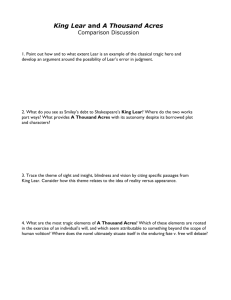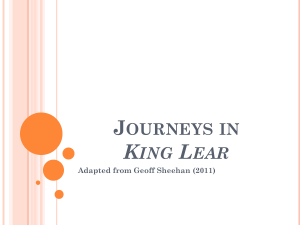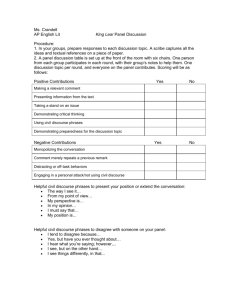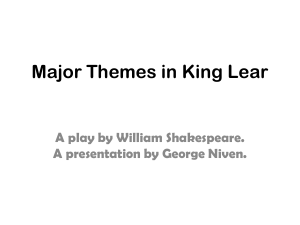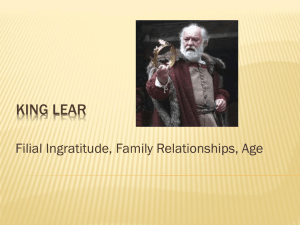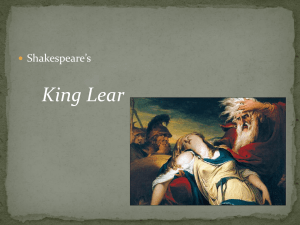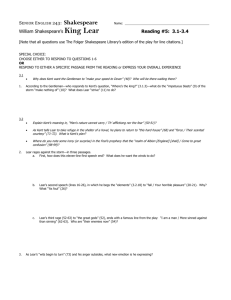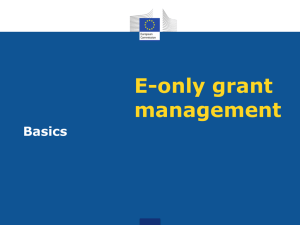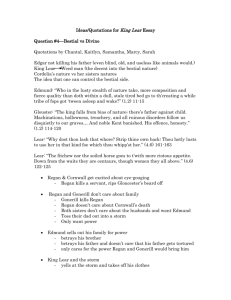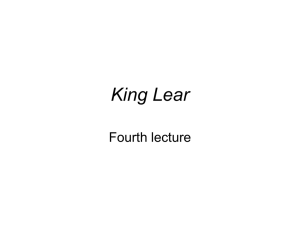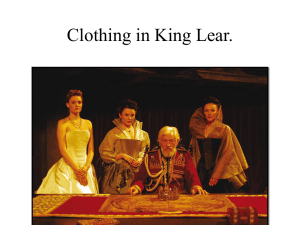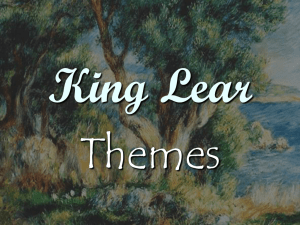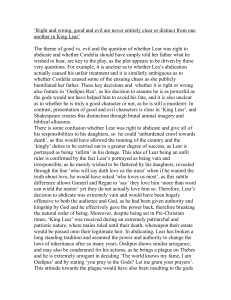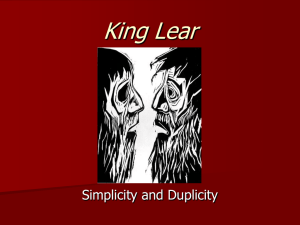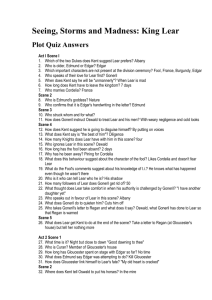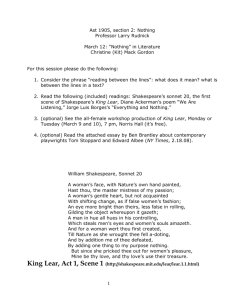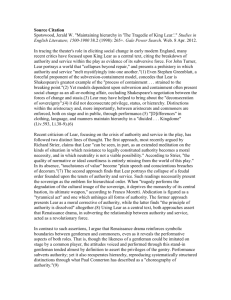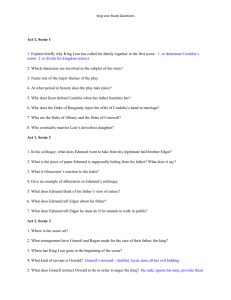Intertextualities EN 1002 – Summer 2010 – Cheryl Crawford Lecture
advertisement
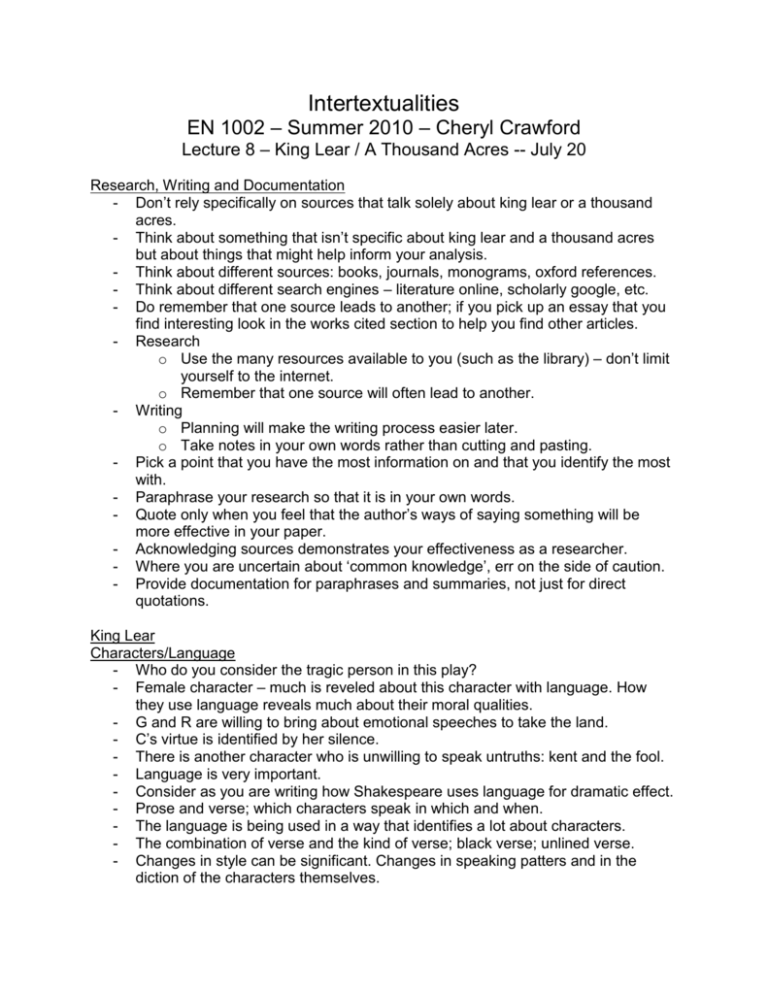
Intertextualities EN 1002 – Summer 2010 – Cheryl Crawford Lecture 8 – King Lear / A Thousand Acres -- July 20 Research, Writing and Documentation - Don’t rely specifically on sources that talk solely about king lear or a thousand acres. - Think about something that isn’t specific about king lear and a thousand acres but about things that might help inform your analysis. - Think about different sources: books, journals, monograms, oxford references. - Think about different search engines – literature online, scholarly google, etc. - Do remember that one source leads to another; if you pick up an essay that you find interesting look in the works cited section to help you find other articles. - Research o Use the many resources available to you (such as the library) – don’t limit yourself to the internet. o Remember that one source will often lead to another. - Writing o Planning will make the writing process easier later. o Take notes in your own words rather than cutting and pasting. - Pick a point that you have the most information on and that you identify the most with. - Paraphrase your research so that it is in your own words. - Quote only when you feel that the author’s ways of saying something will be more effective in your paper. - Acknowledging sources demonstrates your effectiveness as a researcher. - Where you are uncertain about ‘common knowledge’, err on the side of caution. - Provide documentation for paraphrases and summaries, not just for direct quotations. King Lear Characters/Language - Who do you consider the tragic person in this play? - Female character – much is reveled about this character with language. How they use language reveals much about their moral qualities. - G and R are willing to bring about emotional speeches to take the land. - C’s virtue is identified by her silence. - There is another character who is unwilling to speak untruths: kent and the fool. - Language is very important. - Consider as you are writing how Shakespeare uses language for dramatic effect. - Prose and verse; which characters speak in which and when. - The language is being used in a way that identifies a lot about characters. - The combination of verse and the kind of verse; black verse; unlined verse. - Changes in style can be significant. Changes in speaking patters and in the diction of the characters themselves. - Lear’s dissection into madness, he speaks from verse to prose; he speaks in longer sentences. Servants speak in prose. Edgar shifts from his courtly and to his begging persona, from verse to prose. Kent is the only character that doesn’t agree with falsely speech (like Cordelia). Because there are no rules on Shakespeare’s language he uses a lot of context, to show emotion, and truth. ‘Speak what we feel, not what we out to say’ – Albion. Lear’s defiant speech echos the sequence of the storm. He influences the violence about the storms and the understanding of human behaviour. Themes - Responsibility to family. - How things are and how they appear to be. - The way they represent societies in flux. - The theme of triangularity. - Binary oppositions. Land, Language, Power - King Lear: Political order in crises: the king becomes a beggar and goes insane. The people loyal to him have to rally behind him. He is saved by friends and a daughter who was disowned. When the king goes insane, it brings the people to a crisis. The passing of his kingdom from his as the patriarch to his daughters. That reflects the family responsibilities in the play. - King lear: the political and familial chaos, between Goneril and her husband and Regan and her husband. And between England and France. - King Lear: What’s going on while everyone is in crises? There are storms going on when King Lear is going mad. The characters make reference to how the heavens are making connections with the disorder going on. - A thousand Acres: There’s a large storm when Larry is going insane. Instead of having shooting stars he’s always looking at the sky lap. - Insanity is being forecasted by the storms. The first initial moment of crisis with Cordelia, the maddening of Lear, the blinding of Gloucester, and the killing of Cordelia and Lear’s death. - Is the ending of Lear hopeful or tragic? His entire family is dead but Albany and Kent were there. There’s more hope towards Edgar. Maybe Edgar can bring stability to a place that is completely screwed up. Stability: a return to. Edgar presuming the thrown. - KL: A passage of land from a male figure to his daughters, but as well to their son in laws. - Will Edgar and Kent’s knowledge of beggars make their ruling more humane? Triangular Relationships - Triangularity: metaphor for intertextuality and for love triangles. - Rivalry and relationality among stories. A Thousand Acres - ‘To read is to experience freedom. We know that, because reading is one of things that’s proscribed in countries that are very unfree.’ - Smiley: Born in 1949 in California, and she moved to Iowa to complete a phD. - It’s about looking at power. - Asking new questions of old texts. - Think about that in the context of language. - Look at the ways that this text explores the relationship between language, genre and power. - Like Atwood’s Circe/Mud poems, what we have here is a revision of the text that gives the voice of the female character. - Goneril = Ginny - Regan = Rose - Cordelia = Caroline - Lear = Larry - Fool = Marv - Gloucester = Harold - Albany and Kent = Ty - Cornwall = Pete - Edmund = Jess - Edgar = Loren - We never doubt Kent’s moral integrity, or his dedication to Lear. - Why does Smiley choose to not have someone that is identifiable as Kent? - Simley doesn’t want us to symphonise with Larry. - There was a lot more of Lear than Larry. - We are always seeing Larry through Ginny’s perspective. - Kent can be seen as a character who isn’t only true to the King but true to the truth. - Everyone’s truth is different, if the story is told by Larry; his truth is different from Ginny’s. - How much does this text tell us that there is something like truth with a capital T. - We’ve been looking at texts from the perspective of characters that were quiet in the other version. - She wanted to give voice to the evil characters in the play. - Intertextual relationships can cross, generic boundaries. - Depicts the society in a state of flux or transition. - Smiley also includes storms. - Metaphors relating to meteorites (172) and Larry’s anxiety about the space lab. - We’re seeing that Iowa is at a time when people are moving to cities, and it is reflected with a fear of technology. - The water run off into the city. - Rose’s breast cancer has more to do with the arrogant relationship to the human world. - Lear tells Goneril that she will not have children (he curses her). - Ginny’s miscarriages are due to the fertilizer for the land. - Water represents power; you can’t stop water; water is always changing. - The novel begins with water. The soil is made up of the natural history of the world. Epigraphy to the novel: ‘the body repeats the landscape..’ The importance of the epigraph: in relation to what’s beneath the surface. She speaks of how the soil is made up of what’s beneath the surface. Metaphor shifts in the next paragraph, the family’s past also has gaps that are revealed with the story. The water reflects the effect of the woman’s body. No standing water is the ability of a good farmer. Smiley’s intertextual relationships; not just to the Lear material but to other writers.
